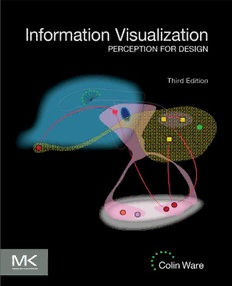Table Of ContentInformation
Visualization
This page intentionally left blank
Information
Visualization
PERCEPTION FOR DESIGN
Third Edition
Colin Ware
AMSTERDAM(cid:129)BOSTON(cid:129)HEIDELBERG(cid:129)LONDON
NEWYORK(cid:129)OXFORD(cid:129)PARIS(cid:129)SANDIEGO
SANFRANCISCO(cid:129)SINGAPORE(cid:129)SYDNEY(cid:129)TOKYO
MorganKaufmannisanimprintofElsevier
AcquiringEditor:MegDunkerley
DevelopmentEditor:HeatherScherer
ProjectManager:PaulGottehrer
Designer:KristenDavis
MorganKaufmannisanimprintofElsevier
225WymanStreet,Waltham,MA02451,USA
©2013Elsevier,Inc.Allrightsreserved.
Nopartofthispublicationmaybereproducedortransmittedinanyformorbyanymeans,electronicormechanical,
includingphotocopying,recording,oranyinformationstorageandretrievalsystem,withoutpermissioninwritingfromthe
publisher.Detailsonhowtoseekpermission,furtherinformationaboutthePublisher’spermissionspoliciesandour
arrangementswithorganizationssuchastheCopyrightClearanceCenterandtheCopyrightLicensingAgency,canbe
foundatourwebsite:www.elsevier.com/permissions.
ThisbookandtheindividualcontributionscontainedinitareprotectedundercopyrightbythePublisher(otherthanasmay
benotedherein).
Notices
Knowledgeandbestpracticeinthisfieldareconstantlychanging.Asnewresearchandexperiencebroadenour
understanding,changesinresearchmethodsorprofessionalpractices,maybecomenecessary.Practitionersandresearchers
mustalwaysrelyontheirownexperienceandknowledgeinevaluatingandusinganyinformationormethodsdescribed
herein.Inusingsuchinformationormethodstheyshouldbemindfuloftheirownsafetyandthesafetyofothers,including
partiesforwhomtheyhaveaprofessionalresponsibility.
Tothefullestextentofthelaw,neitherthePublishernortheauthors,contributors,oreditors,assumeanyliabilityforany
injuryand/ordamagetopersonsorpropertyasamatterofproductsliability,negligenceorotherwise,orfromanyuseor
operationofanymethods,products,instructions,orideascontainedinthematerialherein.
LibraryofCongressCataloging-in-PublicationData
Ware,Colin.
Informationvisualization:perceptionfordesign/ColinWare.–3rd[edition].
pagescm–(Interactivetechnologies)
Summary:“Thisisabookaboutwhatthescienceofperceptioncantellusaboutvisualization.Thereisagoldmineof
informationabouthowweseetobefoundinmorethanacenturyofworkbyvisionresearchers.Thepurposeofthisbookis
toextractfromthatlargebodyofresearchliteraturethosedesignprinciplesthatapplytodisplayinginformation
effectively”–Providedbypublisher.
Includesbibliographicalreferencesandindex.
ISBN978-0-12-381464-7(hardback)
1.Visualperception.2.Visualization.3.Informationvisualization. I.Title.
BF241.W342012
152.14–dc23
2012009489
BritishLibraryCataloguing-in-PublicationData
AcataloguerecordforthisbookisavailablefromtheBritishLibrary.
ForinformationonallMKpublications
visitourwebsiteatwww.mkp.com
PrintedinChina
12 13 14 15 16 10 9 8 7 6 5 4 3 2 1
Typesetby:diacriTech,Chennai,India
Contents
Preface...............................................................................................................................xv
About the Author............................................................................................................xxi
Chapter 1 Foundations for an Applied Science of Data Visualization..................................1
VisualizationStages..................................................................................................................4
Experimental SemioticsBased onPerception.......................................................................5
Semiotics ofGraphics...............................................................................................................6
ArePicturesArbitrary?......................................................................................................7
SensoryversusArbitrarySymbols.........................................................................................9
Properties ofSensoryRepresentation................................................................................12
TestingClaims aboutSensoryRepresentations................................................................15
Representations ThatAreArbitrary.................................................................................15
TheStudyofArbitrary ConventionalSymbols................................................................17
Gibson’sAffordanceTheory.................................................................................................17
AModelofPerceptual Processing.......................................................................................20
Stage1.ParallelProcessing toExtractLow-Level Propertiesofthe VisualScene.........21
Stage2.PatternPerception...............................................................................................21
Stage3.VisualWorkingMemory....................................................................................22
Attention............................................................................................................................22
Costs andBenefitsofVisualization.....................................................................................23
TypesofData..........................................................................................................................25
Entities...............................................................................................................................26
Relationships......................................................................................................................26
Attributes ofEntities orRelationships..............................................................................26
Data Dimensions: 1D,2D,3D,… .................................................................................26
TypesofNumbers..............................................................................................................27
Uncertainty........................................................................................................................28
Operations ConsideredasData.........................................................................................28
Metadata...................................................................................................................................29
Conclusion................................................................................................................................29
Chapter 2 The Environment, Optics, Resolution, and the Display.....................................31
The Environment.....................................................................................................................32
Visible Light.......................................................................................................................32
Ecological Optics...............................................................................................................32
Optical Flow......................................................................................................................34
TexturedSurfacesandTextureGradients........................................................................35
ThePaintModel ofSurfaces.............................................................................................36
The Eye.....................................................................................................................................41
TheVisualAngleDefined.................................................................................................42
vi Contents
Lens....................................................................................................................................43
OpticsandAugmented-RealitySystems..........................................................................44
OpticsinVirtual-Reality Displays...................................................................................47
ChromaticAberration........................................................................................................48
Receptors............................................................................................................................49
SimpleAcuities..................................................................................................................50
AcuityDistribution andtheVisualField.........................................................................52
BrainPixelsandtheOptimalScreen...............................................................................55
SpatialContrast SensitivityFunction..............................................................................59
VisualStress......................................................................................................................62
The OptimalDisplay..............................................................................................................63
Aliasing..............................................................................................................................64
Numberof Dots.................................................................................................................66
SuperacuitiesandDisplays...............................................................................................66
TemporalRequirementsofthePerfect Display................................................................67
Conclusion................................................................................................................................68
Chapter 3 Lightness, Brightness, Contrast, and Constancy................................................69
Neurons, Receptive Fields,and BrightnessIllusions........................................................70
SimultaneousBrightnessContrast....................................................................................73
MachBands.......................................................................................................................74
TheChevreulIllusion........................................................................................................74
SimultaneousContrastandErrorsinReadingMaps......................................................75
ContrastEffects andArtifacts in ComputerGraphics.....................................................75
EdgeEnhancement............................................................................................................76
Luminance, Brightness,Lightness,and Gamma................................................................79
Constancies........................................................................................................................79
Luminance..........................................................................................................................80
DisplayingDetails.............................................................................................................82
Brightness..........................................................................................................................82
MonitorGamma................................................................................................................83
Adaptation,Contrast, andLightnessConstancy..............................................................84
ContrastandConstancy....................................................................................................85
ContrastonPaperandonScreen.....................................................................................85
Perception ofSurface Lightness............................................................................................87
LightnessDifferences andtheGrayScale........................................................................88
ContrastCrispening..........................................................................................................89
Monitor Illuminationand MonitorSurrounds...................................................................90
Conclusion................................................................................................................................93
Chapter 4 Color.....................................................................................................................95
Trichromacy Theory...............................................................................................................96
ColorBlindness..................................................................................................................98
ColorMeasurement................................................................................................................98
ChangeofPrimaries........................................................................................................100
Contents vii
Chromaticity Coordinates................................................................................................102
ColorDifferences andUniformColorSpaces.................................................................105
Opponent ProcessTheory....................................................................................................108
Naming............................................................................................................................108
Cross-Cultural Naming...................................................................................................109
UniqueHues....................................................................................................................109
Neurophysiology..............................................................................................................110
CategoricalColors............................................................................................................110
PropertiesofColorChannels..............................................................................................111
Spatial Sensitivity............................................................................................................111
StereoscopicDepth...........................................................................................................112
MotionSensitivity...........................................................................................................112
Form.................................................................................................................................113
ColorAppearance.................................................................................................................114
MonitorSurrounds..........................................................................................................114
ColorConstancy..............................................................................................................114
ColorContrast.................................................................................................................115
Saturation........................................................................................................................116
Brown...............................................................................................................................117
Applications ofColorinVisualization..............................................................................117
Application 1:ColorSpecificationInterfaces and ColorSpaces...................................117
ColorSpaces.....................................................................................................................118
ColorNaming Systems....................................................................................................120
ColorPalettes...................................................................................................................122
Application 2:ColorforLabeling (NominalCodes).......................................................122
Application 3:ColorSequencesforData Maps...............................................................128
FormandQuantity.........................................................................................................129
Interval Pseudocolor Sequences.......................................................................................132
RatioPseudocolors...........................................................................................................132
SequencesfortheColorBlind.........................................................................................133
Bivariate ColorSequences...............................................................................................134
Application 4:ColorReproduction....................................................................................135
Conclusion..............................................................................................................................138
Chapter 5 Visual Salience and Finding Information..........................................................139
EyeMovements.....................................................................................................................140
Accommodation................................................................................................................142
TheEyeMovementControlLoop...................................................................................142
V1,Channels,andTunedReceptors..................................................................................143
TheElements ofForm.....................................................................................................145
TheGaborModelandVisualDistinctness.....................................................................147
ADifferencingMechanismforFineDiscrimination......................................................149
FeatureMaps,Channels,andLessonsforVisualSearch..............................................150
Preattentive ProcessingandEaseofSearch.....................................................................152
Attention andExpectations.............................................................................................156
Highlighting andAsymmetries.......................................................................................157
viii Contents
CodingwithCombinationsof Features...........................................................................158
CodingwithRedundantProperties................................................................................159
WhatIs NotEasily Findable:ConjunctionsofFeatures................................................159
HighlightingTwoData Dimensions: ConjunctionsThatCanBeSeen........................160
Integral andSeparable Dimensions:GlyphDesign........................................................162
RestrictedClassification Tasks........................................................................................163
SpeededClassification Tasks...........................................................................................164
Integral–SeparableDimension Pairs...............................................................................167
Representing Quantity.........................................................................................................168
RepresentingAbsoluteQuantities..................................................................................169
MultidimensionalDiscreteData:Uniform Representation
versus MultipleChannels...........................................................................................170
StarsandWhiskers..........................................................................................................172
The SearchlightMetaphor andCorticalMagnification..................................................173
UsefulFieldofView........................................................................................................173
TunnelVision, Stress,andCognitiveLoad....................................................................173
TheRole ofMotionin AttractingAttention..................................................................174
MotionasaUserInterrupt.............................................................................................174
Conclusion..............................................................................................................................176
Chapter 6 Static and Moving Patterns...............................................................................179
Gestalt Laws..........................................................................................................................181
Proximity.........................................................................................................................181
Similarity.........................................................................................................................182
Connectedness..................................................................................................................183
Continuity........................................................................................................................183
Symmetry.........................................................................................................................185
ClosureandCommonRegion.........................................................................................186
FigureandGround..........................................................................................................189
MoreonContours...........................................................................................................191
RepresentingVectorFields:PerceivingOrientation andDirection..............................193
Comparing2DFlowVisualization Techniques..............................................................194
ShowingDirection...........................................................................................................196
Texture: TheoryandData Mapping..................................................................................199
Tradeoffsin Information Density:An UncertaintyPrinciple.......................................201
PrimaryPerceptual DimensionsofTexture...................................................................202
TextureContrastEffects..................................................................................................202
OtherDimensionsofVisualTexture..............................................................................203
NominalTextureCodes...................................................................................................204
UsingTexturesforUnivariateandMultivariate MapDisplays...................................205
Quantitative TextureSequences.....................................................................................209
Perception ofTransparency: Overlapping Data..............................................................211
Perceiving Patternsin MultidimensionalDiscrete Data.................................................213
PatternLearning....................................................................................................................218
Priming............................................................................................................................220
Vigilance..........................................................................................................................220
The VisualGrammar ofNode–LinkDiagrams................................................................221
Contents ix
The VisualGrammarofMaps............................................................................................227
Patterns inMotion................................................................................................................229
FormandContourin Motion.........................................................................................231
MovingFrames................................................................................................................232
Expressive Motion...........................................................................................................233
Perception ofCausality....................................................................................................233
Perception ofAnimatedMotion.........................................................................................235
Enriching DiagramswithSimpleAnimation.................................................................236
The ProcessesofPatternFinding.......................................................................................236
Chapter 7 Space Perception.................................................................................................239
Depth CueTheory................................................................................................................240
Perspective Cues..............................................................................................................241
TheDuality ofDepthPerceptioninPictures.................................................................242
PicturesSeenfromtheWrongViewpoint......................................................................244
Occlusion.........................................................................................................................246
Shape-from-Shading.........................................................................................................247
ShadingModels...............................................................................................................248
Cushion Maps..................................................................................................................249
SurfaceTexture................................................................................................................250
CastShadows...................................................................................................................253
Distance BasedonFamiliarSize.....................................................................................255
Depth ofFocus.................................................................................................................255
EyeAccommodation........................................................................................................256
Structure-from-Motion....................................................................................................256
EyeConvergence..............................................................................................................258
StereoscopicDepth...........................................................................................................258
ProblemswithStereoscopicDisplays..............................................................................260
Frame Cancellation..........................................................................................................261
TheVergence–FocusProblem.........................................................................................261
Distant Objects................................................................................................................262
MakingEffective StereoscopicDisplays..........................................................................262
Cyclopean Scale...............................................................................................................264
VirtualEyeSeparation....................................................................................................264
Artificial SpatialCues.....................................................................................................266
Depth CuesinCombination...............................................................................................269
Task-BasedSpacePerception..............................................................................................272
TracingData Pathsin 3DGraphs......................................................................................272
JudgingtheMorphologyofSurfaces.................................................................................276
Conformal Textures.........................................................................................................277
Guidelines forDisplaying Surfaces.................................................................................280
Bivariate Maps–LightingandSurfaceColor..................................................................281
Patterns ofPoints in3DSpace............................................................................................282
PerceivingPatterns in3D Trajectories...............................................................................283
JudgingRelativePositions ofObjectsin Space................................................................284
JudgingtheRelativeMovementsofSelf withintheEnvironment...............................285

